#P.P.O.W Gallery
Explore tagged Tumblr posts
Text


“A beautiful figure without a tongue”, 2024, oil and pencil on canvas


“Open Season”, 2024, oil and pencil on canvas


“Where our love once lay, a dark and tortured jungle grew”, 2023, oil and pencil on canvas
A sense of foreboding looms over the paintings in Sanam Khatibi’s exhibition We Wait Until Dark at P.P.O.W gallery. In the details are smaller skeletons, ritual objects, and dead animals blood soaks the ground. Life and death are personified in both the figures and the natural surroundings. Flowers bloom or wilt, bones are scattered, a hummingbird shares a moment with a skeleton in one painting while a dead bird lies on the ground in another. Khatibi’s works have many potential meanings, like their art historical predecessors, and leave it to the viewer to come to their own conclusions.
From the press release-
…People who devote their lives to art can often cite an event that placed them on their destined path. Among the earliest memories Belgian artist Sanam Khatibi recalls is the day she discovered a book on Hieronymous Bosch left out on the table by her mother. She was five. That one might advance from consuming the rapturous reproductions of The Garden of Earthly Delights at such a young age to painting expansive, primal scenes of a troubled Paradise is one excellent example of artistic “fate.”
In Khatibi’s paintings and sculptures, the veil between desire and restraint, life and death, and the natural and spirit worlds proves thin. Again and again, the artist returns to the figure of a nude goddess navigating a verdant, savage land beyond the protective scrim of “civilization.” In the absence of technology, politics, bills, e-mail, and even clothing, she exhibits her most feral qualities for survival: devouring, eating, attacking, killing, and hunting. Khatibi’s subjects are perennial (desire, seduction, domination, submission), and her references to allegorical forms are extensive (17th-century Dutch still life vanitas, the motif of Death and the Maiden, antiquarian amulets, and anthropological relics), all channeled into displays of human folly and erotic obsession.
Paintings by Khatibi are full of expressions of voracity: for sex, earthly delights, experience, and transcendence, and what happens when you tempt the devil. In Where our love once lay, a dark and tortured jungle grew (2023), a fey skeleton seizes a beautiful maiden by the hair under a lightening blue sky –– a grotesque quid pro quo that recalls Lucas Cranach the Elders’ The Ill-Matched Couple (1553); or even Kawanabe Kyōsai’s Hell Courtesan (1831–1889). Decrepit and aging, his skull sprouts strawlike strands of hair, the last indication of vitality. In Open Season (2024), an Amazonian goddess places an intimate offering of amulets and animal sacrifices before a pool of water. There is a sense of reckless abandon: a human skull, a pomegranate cracked open, blood spilling over the cerulean earth––a feast for ravenous souls.
Khatibi’s Eden is repeatedly transformed into a Bosch-like tale of passionate, potentially fatal encounters (a locus amoenus turned upside down into a “locus terribilis”). In A beautiful figure without a tongue (2024), the skeletal personification of Death reappears. A maniacal grin spreads across his decaying face as he slinks away, clutching an ornate vase to his chest. Are these the spoils of Death to be hoarded in a cavernous underworld?
Throughout the exhibition, Khatibi faithfully intertwines two genres of painting (figurative landscape and still life), leaving seemingly ancillary details from one scene to reveal as sharp memento mori in another––as in Overnight Black Aphids Appeared, growing on the tips of the Sophora Sun King (2023). Here, the reappearance of skulls, amulets, and small creatures sans personnages gives the impression of a romantic sojourn set apart from the larger narrative. Each of Khatibi’s objects pulses into realism with near-scientific observation, appearing magnificent and fragile, possibly even forbidden. Placed against a velvety black ground, they fall into shadow as if pulled amorously into the afterlife. –Lola Kramer
Also included in the exhibition are several smaller works, like the one pictured below. In these darker paintings the details stand out against their black background, but the mystery of their meaning remains.

“Overnight Black Aphids Appeared, growing on the tips of the Sophora Sun King”, 2023 oil on canvas
#Sanam Khatibi#P.P.O.W#P.P.O.W Gallery#Painting#Allegory#Art#Art Shows#Death#Life and Death#New York Art Shows#NYC Art Shows#P.P.O.W NYC#Still Life#Symbolism
1 note
·
View note
Text

Carolee Schneemann, “Meat Joy,” November 16–18, 1964, Judson Dance Theater, Judson Memorial Church, New York (photograph by Robert McElroy, courtesy the Carolee Schneemann Foundation and Galerie Lelong & Co., Hales Gallery, and P.P.O.W., New York and © Carolee Schneemann Foundation / ARS, New York and DACS, London 2022; photograph © 2022 Estate of Robert R. McElroy / Licensed by VAGA at Artists Rights Society (ARS))
11 notes
·
View notes
Photo

Ruins of Rooms by Jimmy DeSana and Paul PJimmy DeSana, Portrait with Dog
Courtesy Jimmy DeSana Trust and P.P.O.W, New York, Meyer Riegger, Berlin/Karlsruhe/Basel und Amanda Wilkinson Gallery, London. © Jimmy DeSana Trust
(via 450108.jpg (Image JPEG, 969 × 1400 pixels) - Redimensionnée (51%))
0 notes
Text







Guadalupe Maravilla's Healing Sound Baths Playlist- Introduction

Guadalupe Maravilla in Conversation with Mindscapes On Youtube

Interactive Resource
Includes biography, selected works, videos, breakdown of exhibitions, art fairs, and news articles by P.P.O.W Gallery.


More videos:
Guadalupe Maravilla: Mariposa Relámpago at the ICA Watershed Length: 5:00 Guadalupe Maravilla & the Sound of Healing | Art21 "New York Close Up“ Length: 9:49 Guadalupe Maravilla: Migrations Visiting Artist Talk Length: 1:21


0 notes
Text
Design research references
Hoch, Hannah, German, 1889-1978. (1919-1920). The Beautiful G
irl. Retrieved from https://library-artstor-org.ezproxy.aut.ac.nz/asset/AHSC_ORPHANS_1071313484
Otto Dix. (1926). The Journalist Sylvia von Harden (Bildnis der Journalistin Sylvia von Harden; Portrait de la journaliste Sylvia von Harden). [painting]. Retrieved from https://library-artstor-org.ezproxy.aut.ac.nz/asset/AWSS35953_35953_30934861
Van Dyke, J.(2016). Dix, Otto (1891–1969). In The Routledge Encyclopedia of Modernism. : Taylor and Francis. Retrieved 21 Aug. 2023, from https://www.rem.routledge.com/articles/dix-otto-1891-1969. doi:10.4324/9781135000356-REM798-1
Dix, O., & Tate Gallery. (1992). Otto Dix, 1891-1969. Tate Gallery.
Carolee Schneemann, Fresh Blood – A Dream Morphology, 1983/2004, c-type print 117 x 166 m. Courtesy: P.P.O.W © Carolee Schneemann
0 notes
Text

Martin Wong
Untitled (Dream Fungus), 1970
P.P.O.W. Gallery
1 note
·
View note
Photo

Carolee Schneemann, "Eye Body: 36 Transformative Actions for Camera" (1963),
Gelatin silver print, printed 2005,
Photograph by Erró, courtesy the Carolee Schneemann Foundation and Galerie Lelong & Co., Hales Gallery, and P.P.O.W., New York and © Carolee Schneemann Foundation / ARS, New York and DACS, London 2022; photograph Erró © ADAGP, Paris and DACS, London 2022)
#art#vintage photography#mirror#reflection#carolee schneemann#visualart#feminist#body positive#equalrights
23 notes
·
View notes
Photo

Clementine Keith-Roach
Mirror (2022)
terra-cotta bowl, jesmonite, paint, steel-and-wood armature, resin
25 1/4 by 43 1/4 by 31 1/2 in.
Photo Damian Griffiths, Courtesy P.P.O.W. Gallery, New York
2 notes
·
View notes
Text




#repost @judithlinhares Judith Linhares (New York City, USA, b. California, USA, 1940-). First image is Winter Sun, 2021. Oil on linen, 42 x 58 inches. Second image is Fever, 2018. Oil on linen, 23 x 30 inches, courtesy of the artist and @ppowgallery P.P.O.W. Gallery. Thanks to @jaygorney1 for the tip.
#Judith Linhares#new york artist#New York art scene#art contemporain#contemporary painting#peinture contemporaine#pintura contemporánea#zeitgenössischemalerei#dogs in art#animals in art#gato salvaje#chat sauvage#contemporary art#tiger#tigre#feline art#feline
3 notes
·
View notes
Photo
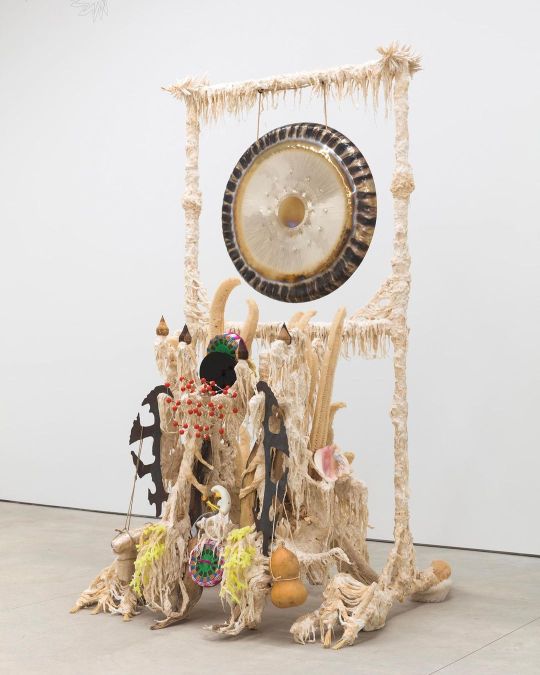
Seven Ancestral Stomachs — Solo presentation by Guadalupe Maravilla at P.P.O.W Gallery, New York, US On view until March 27, 2021 @guadalupe__maravilla @ppowgallery 🔗 in stories 👀 #GuadalupeMaravilla #PPOWGallery #newyork #newyorkexhibitions #us #nyc #nycexhibitions #soloshow #soloexhibition #sculpture #painting #installation #art #contemporrayart #ofluxo #ofluxopatform @ofluxoplatform (em New York, New York) https://www.instagram.com/p/CMAKR42lafk/?igshid=55fc3u3la6cl
#guadalupemaravilla#ppowgallery#newyork#newyorkexhibitions#us#nyc#nycexhibitions#soloshow#soloexhibition#sculpture#painting#installation#art#contemporrayart#ofluxo#ofluxopatform
55 notes
·
View notes
Photo
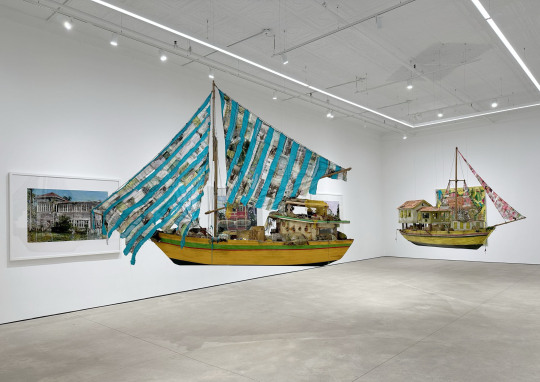
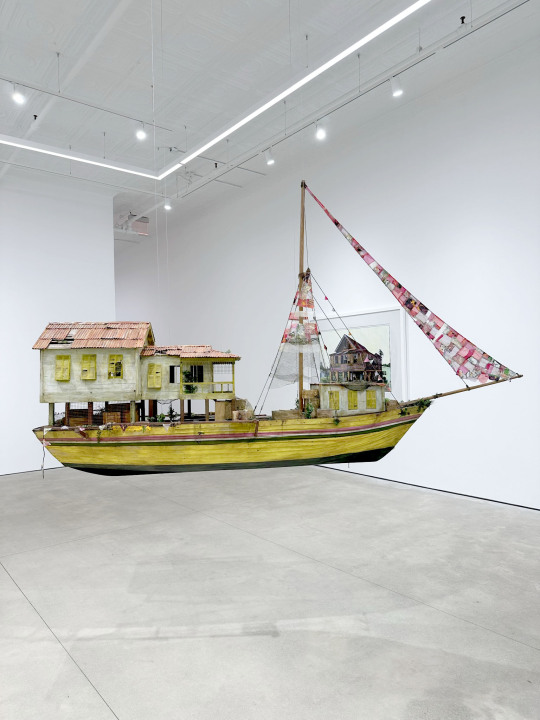
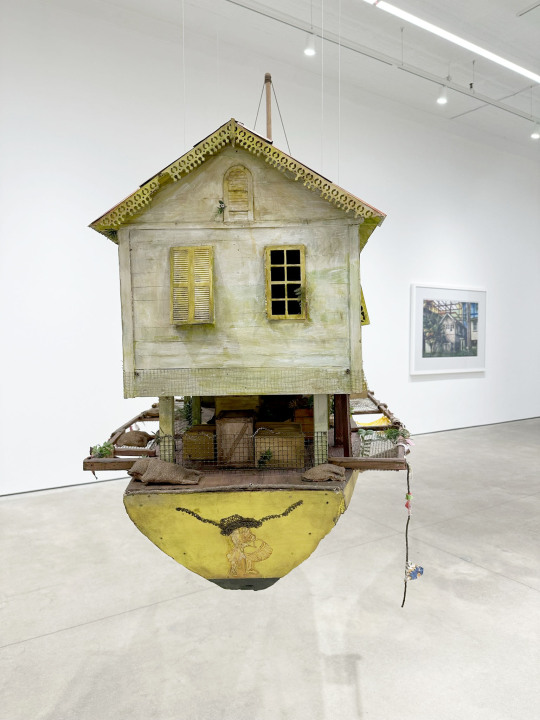
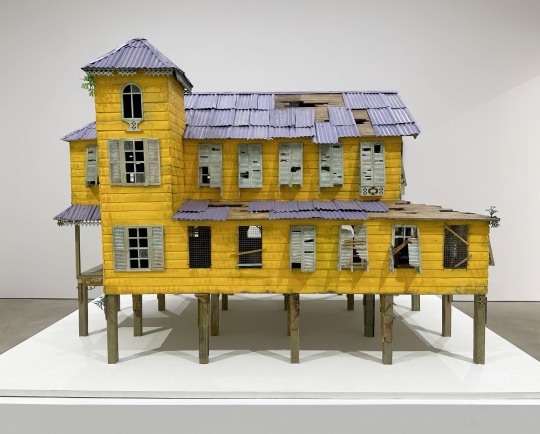
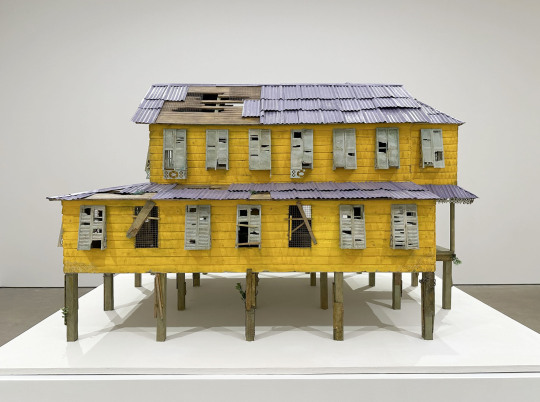
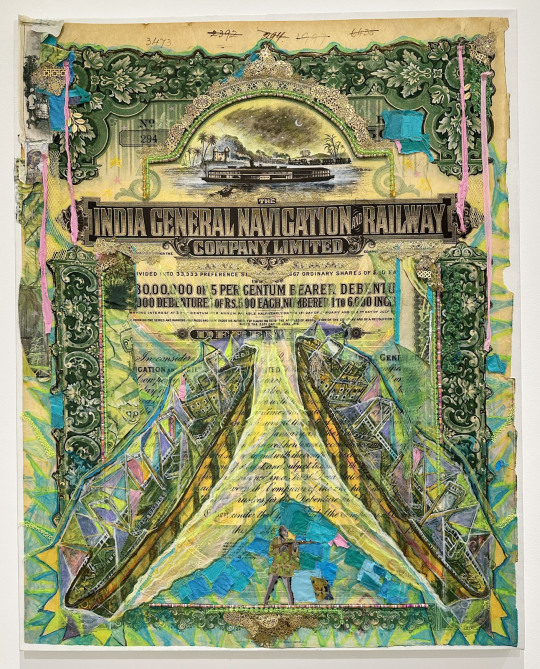


For Hew Locke’s exhibition, Listening to the Land, at P.P.O.W. he has created intricate sculptures and paintings that are fascinating in person.
From the press release-
Locke is known for exploring the languages of colonial and post-colonial power, and the symbols through which different cultures assume and assert identity. Furthering the themes explored in his celebrated commission The Procession at Tate Britain, and his concurrent installation Gilt on the façade of The Metropolitan Museum of Art, this exhibit engages with contemporary and historical inequities while reflecting on the landscape and history of the Caribbean. The exhibition draws its title from a poem by Guyanese political activist and poet Martin Carter which situates itself between two opposing forces of the landscape – sea and forest. Locke’s show features new sculptures and wall works with recurring motifs of stilt-houses, boats, memento mori, and share certificates referencing tensions between the land, the sea, and economic power. Reflecting on these links, Locke notes, ��The land was created to generate money for colonial power, now the sea wants it back.”
Translating to ‘land of many waters,’ Guyana and its physical, economic, and political landscape serve as one of the primary sources for Locke’s work. Having spent his childhood in this newly independent nation, the artist witnessed first-hand an era of radical transformation. Now, the country teeters on the precipice of an oil boom and is one of the world’s fastest growing economies. Juxtaposing personal meditations on the climate crisis with political commentary on the history of a globalized world, Locke contemplates the ways in which colonies were exploited to accumulate capital, and observes how Guyana’s economic future lies in the exploitation of its waters. Locke’s new boat sculptures The Relic and The Survivor embody this broad worldview as the two battered wrecks drift through time and history. Evoking the fragmented and diverse legacies of the global diaspora, the boats’ patchwork sails are interspersed with photo transfers of 19th Century cane cutters and banana boat loaders, while their decks are loaded with cargo that could allude to colonial plunder, trade goods or personal belongings.
Based on an abandoned plantation house, Locke’s newest sculpture Jumbie House 2 features layered images that unveil the spirits that haunt this colonial vestige. Presented alongside are a series of painted photographs of dilapidated vernacular architecture across Georgetown and rural Guyana. Constantly under threat of being washed away by storms or rising sea levels, these crumbling structures echo anxieties surrounding climate change and historical erasure. A new series of mixed media wall works, Raw Materials, is derived from antique share certificates and bonds. Locke richly decorates the appliques with acrylic, beads, and patchwork to draw attention to the complex ways in which the past shapes the present. The image of an 1898 Chinese Imperial Gold Loan behind painted Congolese figures connects the global economy at the height of Empire to current Sino-African trade networks. In another work, a painted representation of a Nigerian Ife mask, alongside an image of David Livingstone, is layered on a French-African Mortgage Bond from 1923, connecting exploration and exploitation of African land, to current conversations surrounding the repatriation of artifacts. Taken together, the works in Locke’s Listening to the Land echo William Faulkner’s adage “The past is never dead. It’s not even past.”
This exhibition closes 4/1/23.
The Procession, mentioned above, can now be seen at Baltic Centre for Contemporary Art, in Gateshead, England until June 11th, 2023.
Gilt, also mentioned above, is on view at The Metropolitan Museum of Art until May 30th, 2023.
#hew locke#p.p.o.w#p.p.o.w gallery nyc#nyc art shows#sculpture#art installation#painting#guyana#baltic centre for contemporary art#the met#the metropolitan museum of art#uk art shows#art#art shows#models#photography#england art shows#gateshead#newcastle
15 notes
·
View notes
Text
Art Basel 2019


Gemini Booth E5 Works by Daniel Buren, Julie Mehretu and Richard Serra

Galerie Michael Haas Booth F4
Works by Paula Modersohn Becker, Jean Fautrier, Pablo Picasso, Anselm Kiefer, Ernst Ludwig Kirchner, Eva Aeppli Antonita Pies, and Jean Miro

Stephen Friedman gallery
Booth K4
Works by Mamma Andersson, Melvin Edwards, Andreas Eriksson, Denzil Forrester, Tom Friedman, Wayne…
View On WordPress
0 notes
Photo

Carlos Motta, still from ‘Legacy’ 2019 P.P.O.W. Gallery
#carlos motta#still#legacy#video#art#video performance#video art#visual artist#visual art#artist#ppow gallery
89 notes
·
View notes
Photo

Allison Schulnik, Desert Pincushion, c.2019, Oil, P.P.O.W. Gallery
46 notes
·
View notes
Photo

Postcard for Martin Wong’s exhibition of New Work at P.P.O.W. Gallery, 1998. Front of card features Wong’s Puerto Rican Day Parade, 1998.
26 notes
·
View notes
Photo




David Wojnarowicz’s In the Shadow of Forward Motion was originally published in 1989 as a limited-run zine/catalog to accompany an exhibition by the artist at P.P.O.W gallery.
Primary Information
19 notes
·
View notes